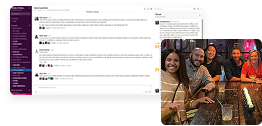It’s that time of the week again and as you’ve probably come to expect with these round-ups, it’s a real mixed bag and #22’s packed with everything from user testing apps and KPIs to user research groups and swag.
If you’re not already, get yourself signed up to our Product Marketing Slack Community for lots more like this every single day.
Q: I'm looking to start the new year right by standardizing metrics for my PMM team. What standard metrics do you use?
A: The scope for this one is really broad but to give you a bit of a master list to pick and choose from, here are some we’ve come across in past threads on Slack and throughout our Product Marketing Insider Podcast series:
- Number of daily, active and/or monthly users
- Overall revenue goals
- Win rates
- Usage of product marketing assets
- Sales confidence - i.e. how confident the sales teams are in pitching your product
- Marketing-qualified leads (MQLs) and sales-qualified leads (SQLs)
- Customer satisfaction - using things like NPS score
- Number of customer case studies collected and published
- Number of win/loss and/or general feedback interviews done
- Launches completed on time.
Q: Does anyone have any good recommendations for kicking off a user research group and driving engagement in said group? We started a closed Facebook group a couple of months ago and invited customers that we have received great feedback from in the past to join. We were able to get a good amount of customers to join, however, engagement has been pretty low.
A:
“I've had the most success with customer advisory/feedback groups or "boards" when I've set a regular cadence: quarterly, monthly, or weekly - whatever is appropriate for your product/business. Also, you need to hammer home what's in it for them: e.g., early access, impact the direction of the product, access to leadership - the CEO, head of product, etc.
“Another best practice to commit to is being disciplined about 1) listening, 2) analyzing the feedback, and, most importantly, 3) reporting back to the group what you did with their feedback. For example, ‘we applied it and you'll get early access by ___’. Or, ‘we looked at it and we did not apply it because ___’. And be transparent about your commitment to this process.”
- Lin Shearer, Founder and Principal Consultant at Spark Consulting
“Make sure there is immediate value for the customers participating in the group, not just value for your team. If the group is only about you getting feedback it is going to be difficult to drive engagement in a Facebook Group. There needs to be something that keeps them coming and engaging with and learning from each other. Otherwise, I'm not sure a Facebook Group is the best place.
“If your priority is user feedback, get that feedback from the places they are already providing it. I would also recommend formalizing the program — let them know up front the time commitment and expectations of their participation.
“Tell them what is in it for them (what kind of benefit do they receive for dedicating time to providing feedback or answers?). Have your asks planned and scheduled rather than random, so that they can plan to participate (if you stick to a Facebook group - schedule an Event or provide an update about new features that are coming and when you'll want their feedback).”
- Madeline Turner, Chief Marketing Officer at LoopVOC
Q: What have been your favourite/most used swag gifts received from an event or conference? And/or what kind of swag have you found most successful for branding and promotion?
A: Quite a few responses came in for this one:
- Backpack
- Powerbank
- KeepCup
- Socks
- Pins
- Stickers
- Mugs
- T-shirts
- Notepads
- Moleskins
- Bag for life.
And if you’re looking to flip the whole swag concept on its head a bit:
“Our swagless campaign at our last conference was a big hit; we took the money we’d use for swag, and along with sponsor donations, let attendees donate that money to one of four cause.”
- Richard Seroter, VP of Product Marketing at Pivotal
Read up on it here.
Q: I’m curious to know if anyone has tried user testing websites? It looks to me like the tools we have today only let you user test an app. If there are tools to user test a website and get (video + audio + survey) feedback, do they allow you to target by roles? I.e. From developers or marketers, etc.
A: A couple of fellow PMAers said they’re currently using and impressed with UserTesting - this one also made the cut in our Product Marketing Tools of Choice report.
Here are a couple of others that might be worth checking out too:






.png)
.png)










 Follow us on LinkedIn
Follow us on LinkedIn



.svg?v=1b8371da9d)